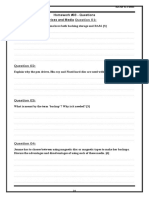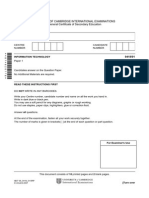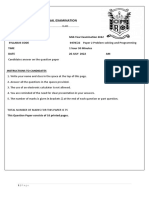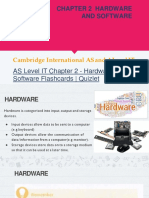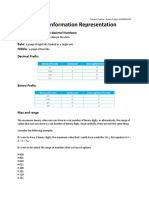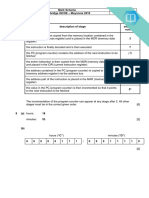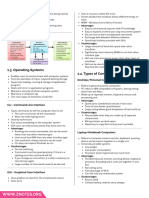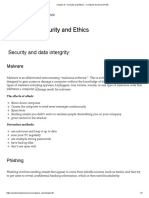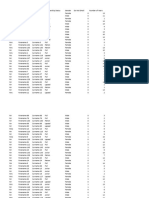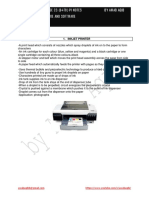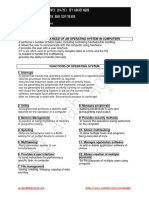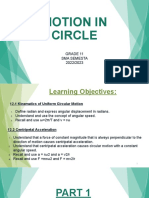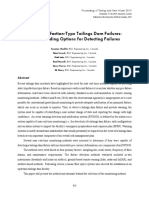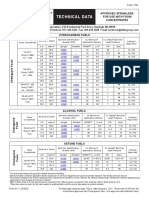GCSE CS (2210) / IGCSE CS (0478) P1 NOTES BY AWAB AQIB
CHAPTER 1.3: HARDWARE AND SOFTWARE
1.3.5 Memory, Storage and Media
TYPES OF STORAGE
1. PRIMARY STORAGE
-Main memory inside a computer
-Directly accessed by CPU, faster access than secondary storage
-both volatile and non-volatile
e.g.
1- Random Access Memory (RAM)
-is a hardware device
-allows information to be stored and retrieved on a computer
-RAM is a volatile memory and requires power to keep the data accessible
-RAM normally has a larger capacity than ROM
2- Read Only Memory (ROM)
-is a hardware device
-Stores basic start up instructions for a computer e.g. basic input/output system (BIOS)
-Stores bootstrap loader
-ROM contains nonvolatile data, meaning it keeps it data even if the device loses power
-Data can be read from and written to RAM, ROM can only be read from
2. SECONDARY STORAGE
-non-volatile, persistent memory that is accessed by a device that is part of computer
-not directly accessed by the CPU
e.g.
1- Hard Disk Drive (HDD)
-HDD is an electromechanical data storage device that uses magnetic storage
-to store and retrieve digital information using one or more rotating magnetic disks
2- Solid State Drive (SDD)
Device that stores data by controlling the movement of electrons
within a microchip; there are no moving parts hence more durable
-Has faster random access
-Has a quick start up/shut down time (reduced latency)
-Is very small
-Is very light
-Consumes very little power
awabaqibb@gmail.com https://www.youtube.com/c/awabaqib/
� GCSE CS (2210) / IGCSE CS (0478) P1 NOTES BY AWAB AQIB
CHAPTER 1.3: HARDWARE AND SOFTWARE
1.3.5 Memory, Storage and Media
Why is Solid State Drive (SSD) replacing Hard Disk Drive (HDD)
-lower/less power consumption/more energy efficient
-runs quieter
-data access is faster
-occupies less physical space/more compact
-lighter, so more suitable for a portable computer/laptop
-no moving parts so more reliable/durable in a portable computer/laptop
Why many web servers still use Hard Disk Drive (HDD) technology
-HDD is cheaper for larger amounts of storage space
-HDD has greater longevity for read/write functions
-HDD are trusted technology
-No requirement for the increased speed of SSD
3. OFFLINE STORAGE
-non-volatile memory that can be removed from a computer system
-must be physically connected to computer to obtain stored data
-used to store files as a backup
e.g.
1-Compact Disk (CD)
-Small plastic disc on which music or other digital information is stored
-in the form of a pattern of metal-coated pits from which it can be read
-using laser light reflected off the disc
2-Digital Versatile Disk (DVD)
-Optical storage media that uses a single spiral track
-uses dual layer technology, allowing high data storage capacity
3-Digital Versatile Disk RAM (DVD-RAM)
-Optical storage media that uses concentric tracks
-allowing writing and reading to take place at the same time.
4-External SSD
-similar to internal SSD except it can be easily removed after data has been copied
-connected to computer via USB port while internal SSD is connected via SATA controller
5-Blu-Ray
-Optical storage media
-has high storage capacity by using blue laser technology
(continued)
awabaqibb@gmail.com https://www.youtube.com/c/awabaqib/
� GCSE CS (2210) / IGCSE CS (0478) P1 NOTES BY AWAB AQIB
CHAPTER 1.3: HARDWARE AND SOFTWARE
1.3.5 Memory, Storage and Media
6-Flash Memory
-Nonvolatile memory chip used for storage and for transferring data
-between a personal computer (PC) and digital devices
-It has the ability to be electronically reprogrammed and erased.
-It is often found in USB flash drives, MP3 players, and digital cameras
CLASSIFICATION OF STORAGE DEVICES
Optical Magnetic Solid State
CD-ROM Hard Disk Drive (HDD) Solid State Drive (SSD)
DVD-ROM Floppy Disk Memory stick
DVD-RAM Magnetic Tape Flash memory
Blu-Ray
How is data written and read in an Optical Media
-Red laser is used (blue in case of Blu-Ray), shines onto surface of the disk
-It is rotated at a constant speed to be read
-Surface is covered in a track that spirals from the center
-Data is represented on the surface using pits and lands
-Pits and lands represent binary values
-Pits reflect light back differently to the area in between/land
-Optical device can determine the binary value from the light reflection
How is data written and read in a Magnetic Media
-surface of magnetic disk/tapes are coated with millions of iron particles
-allowing data to be stored on them
-the surface is divided into concentric tracks, which save data on them
-each track is sub-divided into sectors
-the particles act as magnets when they are exposed to a magnetic field
-magnetic disk/tapes contain read-write heads
-they contain electromagnets that generate magnetic fields
-in the iron particles, as the head passes over them
-a magnetic field’s pull means a binary 1 and a 0 otherwise
-while reading, read-write heads have no magnetic field
-storage medium charges the magnet in head
-causes a current to flow through head based on the polarity
-this way data is sent from read-write heads into the memory
awabaqibb@gmail.com https://www.youtube.com/c/awabaqib/
� GCSE CS (2210) / IGCSE CS (0478) P1 NOTES BY AWAB AQIB
CHAPTER 1.3: HARDWARE AND SOFTWARE
1.3.5 Memory, Storage and Media
How is data written and read in a Solid State Media
-store data by controlling the movement of electrons
-within NAND chips
-use of NAND only allows to read or erase a block of data at a time
-The data is stored as 0s and 1s in millions of tiny transistors within the chip
-This effectively produces a non-volatile rewritable memory
-also use Electronically Erasable Programmable Read-Only Memory (EPROM)
-main difference is that it uses NOR chips than NAND making operations faster
-EPROM allows data to be read or erased in single byte at a time
SUMMARY OF STORAGES
awabaqibb@gmail.com https://www.youtube.com/c/awabaqib/
� GCSE CS (2210) / IGCSE CS (0478) P1 NOTES BY AWAB AQIB
CHAPTER 1.3: HARDWARE AND SOFTWARE
1.3.5 Memory, Storage and Media
CALCULATING STORAGE REQUIREMENTS OF A FILE
Storage Unit Size in decimal Number of Bits
Bit -
Byte 8 bits
Nibble 4 Bytes
Kilobyte 1024 bytes 210
Megabyte 1024 Kilobytes 220
Gigabyte 1024 Megabyte 230
Terabyte 1024 Gigabyte 240
Petabyte 1024 Terabyte 250
-We store images in an 8-bit color graphics in computer’s memory
-such that each pixel is represented by one 8-bit byte
-The maximum number of colors that can be displayed at any one time is 256
To calculate the size of a file whose resolution is n x m (pixels) with w color-depth
-multiply n and m
-multiply product with w color-depth and divide by 8
-convert the answer to kB/MB/GB/TB
(𝑝𝑟𝑜𝑑𝑢𝑐𝑡 𝑜𝑓 𝑛 𝑎𝑛𝑑 𝑚) 𝑥 𝑤
8
-to convert the answer from bytes to Kilobytes, divide it by 1024
-to convert the answer from bytes to Megabytes, divide it by 10242
-to convert the answer from bytes to Gigabytes, divide it by 10243
To calculate the size of a sound file that is b seconds long and is sampled at c times
per second. Each sample is saved using Y-bits
-multiply b and c
-if each sample is saved in 8 bits then convert it straight to kB/MB/GB/TB
-if each sample is not saved in 8 bits rather saved at Y color-depth then:
(𝑝𝑟𝑜𝑑𝑢𝑐𝑡 𝑜𝑓 𝑎 𝑎𝑛𝑑 𝑐) 𝑥 𝑌
8
-to convert the answer from bytes to Kilobytes, divide it by 1024
-to convert the answer from bytes to Megabytes, divide it by 10242
-to convert the answer from bytes to Gigabytes, divide it by 10243
(continued)
awabaqibb@gmail.com https://www.youtube.com/c/awabaqib/
� GCSE CS (2210) / IGCSE CS (0478) P1 NOTES BY AWAB AQIB
CHAPTER 1.3: HARDWARE AND SOFTWARE
1.3.5 Memory, Storage and Media
Example 1
-An image is 256 px high and 200 px wide with a 16-bit color depth. Calculate its size in kB.
Total resolution: 256 x 200 = 51,200
51,200 𝑥 16
Size in bytes: = 102,400 bytes
8
102,400
Size in KiloBytes: = 100KB
1024
Example 2
-A 32 second-long sound clip will be recorded. The sound will be sampled at 16000 times a
second. Each sample will be saved using 8-bits. Calculate the size in Kilobytes.
Size in bytes: 32 x 16000 = 512,000 bytes
512,000
Size in KiloBytes: = 500KB
1024
Example 3
-The current status of the engine is sent to a computer in the Airplane. Each piece of data
collected is 8 bytes in size. Data collection occurs every 30 seconds. Calculate the number
of kilobytes that would be needed to store the data collected during a 10-hour flight.
bytes : duration
8 bytes 30 sec
x bytes 10*60*60 sec
288000
Bytes needed for 10-hour: x =
30
x= 9600 bytes
9600
x= KiloBytes
1024
Size in KiloBytes: x= 9.4 KB
awabaqibb@gmail.com https://www.youtube.com/c/awabaqib/












